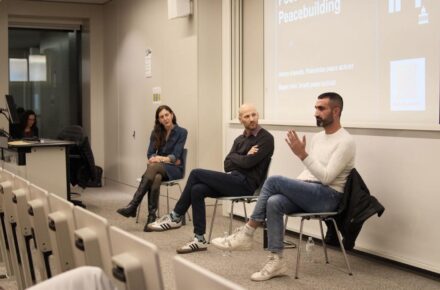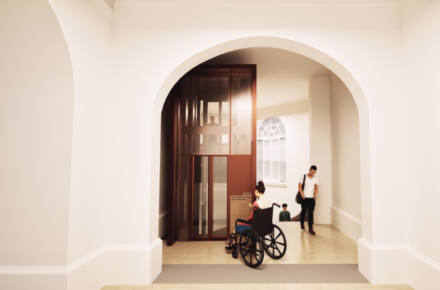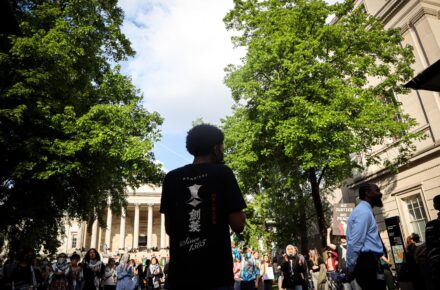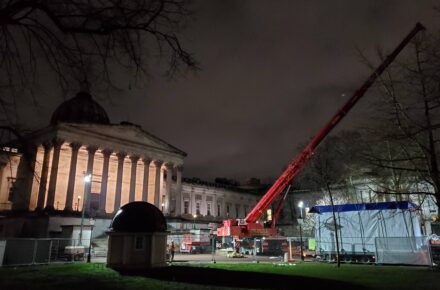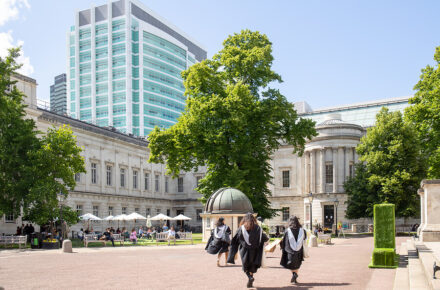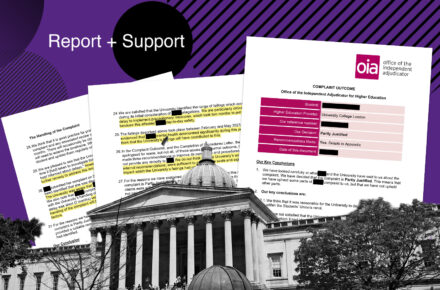Zhenya Robinson and Samir Ismail
UCL’s Bartlett School of Architecture (BSA) has consistently ranked amongst the top in the world for architecture, ranking 1st in the QS World Rankings in 2020, and 3rd in 2022. Aspiring architects across the world flock yearly to the BSA to learn from the foremost Professors in the discipline, who lead successful careers outside the classroom and offer the students hands-on experience.
However, for many students, it isn’t the smoothest sail. Our investigation revealed a stressful, extremely competitive, and high-pressure environment.
The goings-on of the BSA have been the subject of some obloquy by the press in recent years. The Guardian has published reports of discrimination over the past decade and a half, specifically the systematic mistreatment of women and people of colour, including biased grading.
UCL took steps to address this, and the Guardian Article goes so far as to note recent improvements. Another promising decision made by UCL was to contract the Howlett-Brown consultancy to investigate the claims that had been made against the BSA.
With the report only having recently been published, The Cheese Grater believes it is important to bring to light key allegations made against various tutors and senior management. Moreover, having conducted interviews with current BSA students it is clear that while a number of problematic tutors have been removed, many problems still persist.
Worryingly, it seems that UCL has no intention in addressing some of the structural issues that both the Howlett Brown report and our investigation found.
The Bartlett is notoriously difficult to get into, and the competition for a place is fierce. But it has become clear that the competition between students within the institution is equally, if not more rigorous. One interviewee explained that even in the first few months of the course, he felt that some of the students “have had no interest in making friends and were very dedicated to the course.” Another explained that many would brag about what little sleep they had, “There was competition about who was working the most and working the most hours.”
When asked about how this competition manifested, a student revealed- “Competition exists in two ways, explicit, where you don’t want to help someone else and the constant [implicit] comparison which is common in visual subjects.”
The Cheese Grater discovered that competition often went beyond this- “There was some sabotage in our year though… Some people would steal other people’s work or throw them in bins.” It is obvious that such behaviour is unacceptable. However, credit where credit’s due. We found that when this happened, some tutors would account for this in examinations and provide marks accordingly.
The cause of this competitive environment is explained in part by the Unit system. After their first year at the BSA, a student is expected to apply for a Unit. The application process is an interview in which students are asked about their work.
Each Unit houses between 15-17 students under Professors who carry out their own distinctive methods on both teaching and practising architecture. With places in any one Unit being limited and with often only the work you have done in first year to go off of, it is a clear cause of stress and competition.
A second year student applying for their third year unit informed us that “one of the units [they were] applying to is very competitive because people realise that there are nicer tutors, or the way they teach produces better work in a less toxic way.” Noticeably, it is not only the limited chance to do a subject you are interested in within architecture that causes steep competition between students, but also the attempt to work under tutors who inspire their students ‘in a less toxic way’.
This environment, evidently commonplace at the Bartlett, is made possible by the intensive workload shouldered by all students. In understanding the sheer workload that takes place at the Bartlett, The Cheese Grater discovered it does not only compound stress, but also creates an accessibility issue.
During COVID, when all students were working from home, it was obvious that essay-based courses were clearly advantaged in the extent to which they could adapt their courses. However, more practical courses like Architecture needed to find innovative solutions to allow students the chance to gain the hands-on experience required. BSA allowed students to book time in the studio, which although limited, at least gave some the chance to work with materials and build the models required.
However, this was obviously not available to those who were trapped abroad and fundamentally unable to come into the studio. One interviewee who studied during COVID elucidated this fact- “The general trend was that students who had access to the studios did better and tutors were more satisfied with the work they produced because they had that studio experience.” Beyond an ability to properly reach out to those disadvantaged by COVID, Bartlett also does not want to give their students time to rest. “They expected you to do work all throughout the holidays, so when do I get rest, you know?”
Furthermore, while Wednesdays are traditionally a free day for students at BSA, and UCL as a whole, this interviewee told us that “sometimes, just 2 hours before, they decide to put on meetings and drawing classes, and you’re basically fucked if you don’t show up. If you have a part time job, how do you decide which one you go to?”
The course is also structured in an all-or-nothing grade system, The Cheese Grater learned. “Priorities get skewed because you’re only really graded on one big project… if that is not going well from the get go, you start to feel like you’re mucking up your degree.” Besides the internal competition, the seemingly never-ending workload, and the clear accessibility issues for students, the report detailed an unhealthy relationship between students and professors that has gone on for decades and still persists.
The Howlett Brown report spanned over a 30 year period (1990 – 2020) and investigated a number of truly troubling claims. The report noted two common themes that ran throughout the complaints; the first was that mental health was never a priority for those at the top of the BSA. The second was the presence of a ‘Boys Club’ culture near the leadership, which enabled the protection of certain problematic staff members despite complaints from students and staff alike.
One senior staff member had been brought up twenty-four times in separate interviews for inappropriate behaviour including sexist comments, mocking and demeaning students, and ‘verbally attack[ing] female students’. Another senior leader had been identified twenty-seven times for ‘bullying, misogynistic and anti-Semitic behaviour’. Further, this same staff member had been accused of creating a ‘boys club’ which acted to protect favoured staff from their inappropriate actions. This included ‘deleting complaints and normalising bad behaviour’.
Despite the obviously unacceptable deeds perpetrated, it exposes that UCL has, for the better part of thirty years, been unable to properly protect student anonymity and treat complaints with the respect and due process they deserve. The report also exposed that one senior tutor continuously made racist comments ‘particularly towards Chinese students’.
An essential feature of the architecture course is the Crit: a ten minute presentation made by a student, followed by ten minutes of questions asked by tutors and when invited, fellow students. Crits are useful for students to understand areas of improvement, and provide realistic insight into the professional sphere, where professionals are quizzed on their work by architects and specialists such as engineers or technicians. However, both the report, and our interviews revealed a multifaceted nature to these Crits, where the criticism often went beyond a student’s artwork.
A certain Professor was mentioned several times in interviews with first year students. One explained how while many tutors respect the traditional format of the Crits, this Professor “does not give a shit about that”. Apparently with this Professor, “whenever a compliment came, there was a bit of personal humiliation as well.”
They allegedly said of a student, ‘“I don’t know this guy, I don’t like this guy, I don’t want to know this guy, but he knows how to think” during a Crit in the Easter Term. In this student’s final Crit, the Professor in question started clicking her fingers and said, “Move on to your building, you’re boring.” One student added, “[They were] talking about my models and said, ‘Your models are very pretty. Not you though, you’re quite ugly’.” Another student recalled, ‘I remember [them] saying to a couple people that Asian students are all very selfish…it’s part of their culture to be selfish’.
While Crits are integral to student development, it seems that they are also destructive towards student mental health. The Cheese Grater learned that while they believed “tutors [would] ideally help you out”, after being invited to first year Crit as a second year, they learned the harsh reality it could be- “What I actually saw in the Crits as a guest was guest tutors saying ‘that looks grim’.” Almost all our interviews revealed how crying was commonplace at the Bartlett, and “students cry because they have no concrete feedback on what to do.”
The value of a Crit is in providing a student the opportunity to understand their work from other people’s perspectives and gain constructive insight into their efforts. Making personal demeaning comments towards students and casually making racist statements outside of class creates an environment of fear and trepidation.
It is concerning that despite multiple anecdotes illustrating a single Professor’s actions, one quite integral to all first year students doing BSc Architecture, our interviewees seemed to accept it as the Professor’s demeanour.
It is not all bad though. The report notes that some students had been invited to parties where cocaine had allegedly been consumed. Additionally, five instances had been noted where tutors had engaged in relationships with students during their time at BSA. One student gave anecdotal evidence of this. They said they knew of a case where a Professor allegedly said to a female student, “I’ll fail you if you don’t go on a date with me.”
Interestingly, another interviewee, who is on the new MSci course at the BSA, detailed how with this new course, the Bartlett was attempting to take a ‘more progressive’ approach to teaching architecture. They have removed the Unit system and included more group work, which “helps with feeling stressed in isolation.” While it shows that the Bartlett is somewhat self-aware, it is more worrying than reassuring- a confirmation that the Unit system is destructive to students’ mental health.
He also told The Cheese Grater how the students are disproportionately disadvantaged by the negative press the Bartlett has attracted. “The teachers at the Bartlett have their careers made, but it’s the students that have to deal with the tarnished reputation of our school that we’re graduating from.” He told us how employers and colleagues have been reacting poorly when they hear a student studies at the Bartlett- “it’s really quite embarrassing.”
It is not easy to stay at the top of the charts, and one must understand that the any-means-necessary approach to success is clearly one that has ensured BSA’s success in comparison to other architecture schools. Lying to students about their progress? Tearing apart long-worked-at architectural designs? A slew of racist and sexist remarks? We are forced to question the utility of all these techniques to ensure that students do the best they can do. Further, even if all of these did in fact work to promote the quality of work being produced, was the cost of many students’ mental health and overall university experience a worthy one?
This article appeared in CG issue 83.



